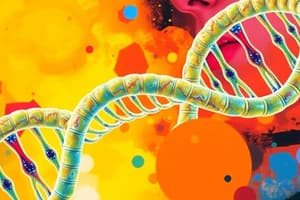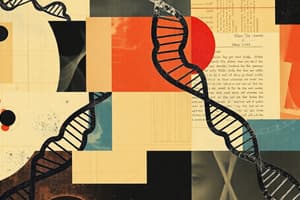Podcast
Questions and Answers
What is the primary purpose of denaturing in the PCR process?
What is the primary purpose of denaturing in the PCR process?
- To replicate the DNA strands
- To cool the DNA strands for annealing
- To break the bonds between DNA strands (correct)
- To add nucleotides to the primers
Which enzyme is specifically used during the extension phase of PCR due to its heat resistance?
Which enzyme is specifically used during the extension phase of PCR due to its heat resistance?
- DNA ligase
- Taq polymerase (correct)
- Reverse transcriptase
- RNA polymerase
What is a cytokine's role in medical biotechnology?
What is a cytokine's role in medical biotechnology?
- It is used to clone human cells
- It serves as a genetic marker
- It acts as a DNA polymerase
- It helps fight infections (correct)
What is a significant application of pharmacogenomics?
What is a significant application of pharmacogenomics?
What is the purpose of creating transgenic crops?
What is the purpose of creating transgenic crops?
What was the first human protein produced using genetically engineered bacteria?
What was the first human protein produced using genetically engineered bacteria?
What does the transformation of a bacterium with the human insulin gene result in?
What does the transformation of a bacterium with the human insulin gene result in?
In the creation of a transgenic crop, what is T-DNA used for?
In the creation of a transgenic crop, what is T-DNA used for?
What characteristic does the transgenic purple tomato possess?
What characteristic does the transgenic purple tomato possess?
What is an application of biotechnology in forensic science?
What is an application of biotechnology in forensic science?
What is the primary purpose of biotechnology?
What is the primary purpose of biotechnology?
Which step is NOT part of gene cloning?
Which step is NOT part of gene cloning?
What type of DNA is used to create recombinant DNA in the gene cloning process?
What type of DNA is used to create recombinant DNA in the gene cloning process?
What is the purpose of the transformation step in gene cloning?
What is the purpose of the transformation step in gene cloning?
Which enzyme is responsible for combining isolated genes with plasmid DNA?
Which enzyme is responsible for combining isolated genes with plasmid DNA?
What does the polymerase chain reaction (PCR) primarily accomplish?
What does the polymerase chain reaction (PCR) primarily accomplish?
What is the first step in the gene cloning process?
What is the first step in the gene cloning process?
Which of the following is a characteristic of plasmids?
Which of the following is a characteristic of plasmids?
What is the significance of the selection step in gene cloning?
What is the significance of the selection step in gene cloning?
Which application would NOT typically involve biotechnology?
Which application would NOT typically involve biotechnology?
Flashcards are hidden until you start studying
Study Notes
Working with DNA
- Scientists begin their work by determining the DNA sequence, enabling isolation and manipulation of specific regions.
- Processes include cloning, amplifying, and utilizing DNA sequences for various applications in biotechnology.
Biotechnology Overview
- Biotechnology involves altering the genetic makeup of organisms for beneficial human purposes.
- Objectives include creating useful organisms (e.g., pest-resistant crops) and developing treatments for genetic disorders.
Gene Cloning
- Gene cloning isolates and replicates specific genes for uses like gene therapy.
- Involves four steps:
- Isolation: Restriction enzymes break DNA at specific sequences to isolate genes.
- Ligation: DNA ligase combines isolated genes with plasmid DNA, creating recombinant DNA.
- Transformation: Recombinant DNA is introduced into living cells, typically bacteria, a process also known as genetic engineering.
- Selection: Grown transformed bacteria are screened to ensure successful incorporation of recombinant DNA.
Polymerase Chain Reaction (PCR)
- PCR produces multiple copies of a specific DNA segment, essential for genetic testing and research.
- Key steps:
- Denaturing: DNA heated to separate strands.
- Annealing: Mixed with primers that bond to complementary DNA sequences.
- Extension: Taq polymerase enzyme adds nucleotides to form new DNA strands, repeating the cycle to amplify DNA.
Applications of Biotechnology in Medicine
- Gene therapy can address genetic disorders by using cloned normal genes.
- Biotechnology enables the production of human proteins by genetically modifying bacteria.
- Example: Human insulin, produced by transforming bacteria with the cloned insulin gene for type 1 diabetes treatment.
Pharmacogenomics
- Studies how genetic variations affect individual responses to medications.
- Aims to personalize medical treatments based on genetic profiles, with significant advancements in cancer treatment.
Synthetic Biology
- Focuses on engineering biological systems for novel functions.
- Examples include using living cells for memory devices and biofuels from yeast.
Applications of Biotechnology in Agriculture
- Biotechnology has led to the development of transgenic crops, which are genetically modified for specific traits.
- The process involves using Ti plasmids to transfer genes into plant genomes, resulting in crops with enhanced features.
- Examples include drought resistance, better taste, and pest resistance.
- Notably, the first transgenic plant, a tobacco plant, was developed in 1982.
Applications in Forensic Science
- Biotechnology plays a crucial role in forensics, enhancing capabilities for DNA analysis and identification.
Studying That Suits You
Use AI to generate personalized quizzes and flashcards to suit your learning preferences.




